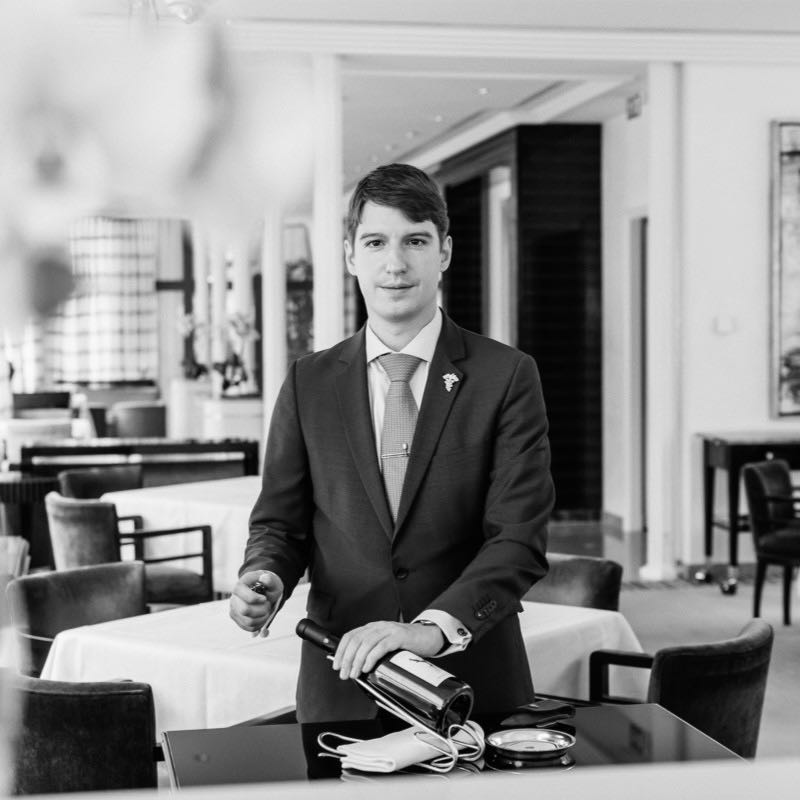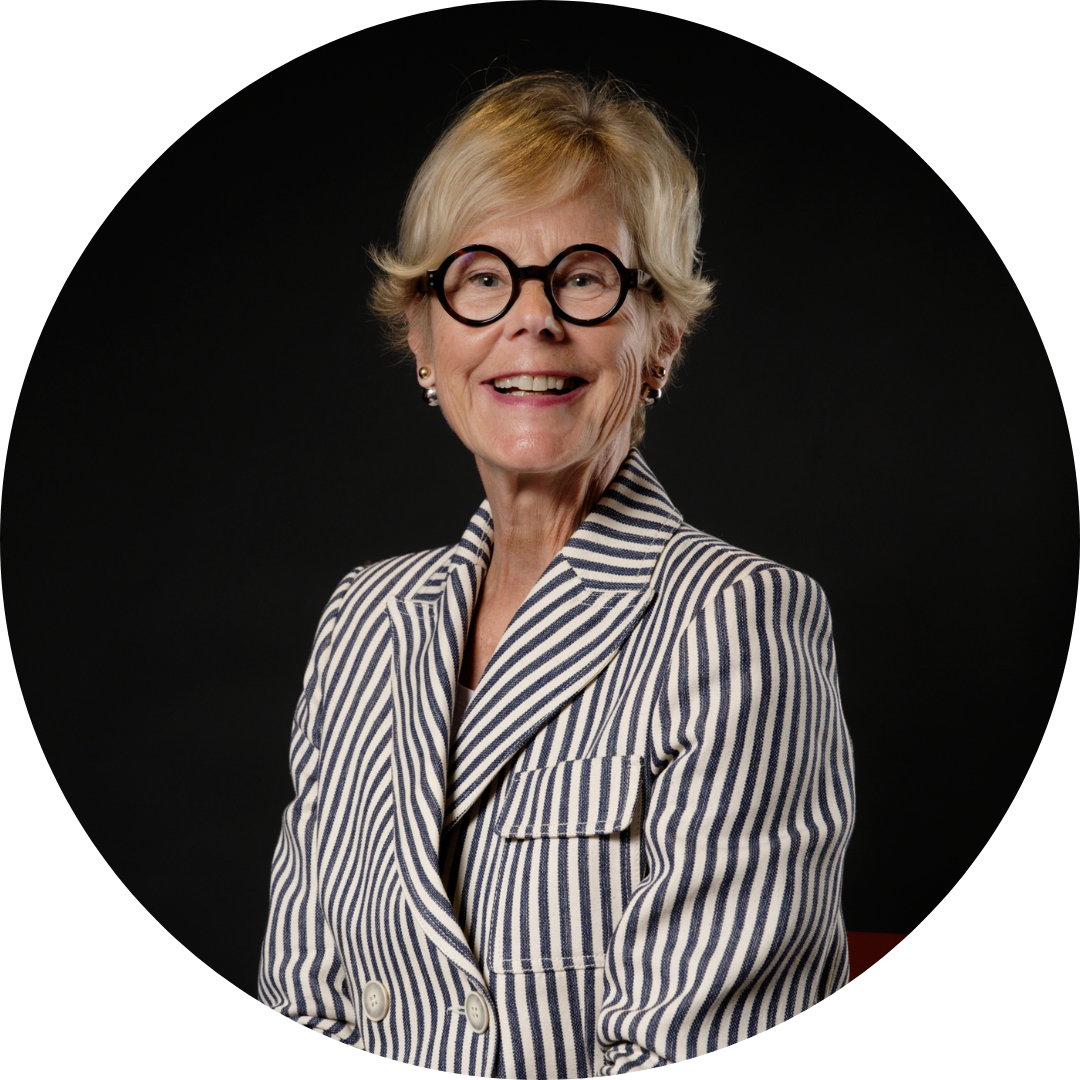Marc Almert
Chef Sommelier Baur au Lac & Baur au Lac Vins
Membre de la direction du Baur au Lac Vins
ASI Meilleur Sommelier du Monde 2019
Marc Almert, originally from Cologne, obtained an International Baccalaureate in English in his hometown. He chose to pursue a career in the hospitality sector by completing a 3-year training program in Cologne. This program, designed as an apprenticeship, combined one month of study at school with three months of work in a hotel restaurant, where he was entrusted with various tasks such as kitchen assistance and administrative responsibilities, among others.
Marc then joined a management trainee program with several internships, particularly in marketing and gastronomy. Quickly, he discovered that wine was his true passion. His first position as a junior sommelier took him to Wiesbaden, where, under the guidance of a passionate and dedicated head sommelier, he gained solid expertise at the age of 22. Subsequently, Marc became the head sommelier in a two-star restaurant in Hamburg.
Then in 2017, he joined the prestigious establishment Baur au Lac in Switzerland, where he currently serves as Chief Sommelier. His brilliant career took off in 2019 when he was named the best sommelier in the world. He is also part of the executive committee of Baur au Lac Vins, renowned for offering one of the finest selections of Bordeaux wines. At Roland Coiffe & Associés, we are proud to be one of their partners in Bordeaux.
Gerda: What are the most rewarding and demanding aspects of your daily work?
Marc Almert: For me, the most beautiful thing in the world of wine is its diversity. Every day is unique because we taste different wines, which allows us to travel a lot and work both with clients and as a team. No day is like the previous one, which brings me immense gratitude. It allows me to experience something new every day. As for the demands, every profession has its difficult aspects or stressful periods, but with a good team, these moments are more bearable and help overcome these challenges.
G: How do you stay in shape?
Marc Almert: In Switzerland, we are fortunate to have many beautiful lakes, and in the summer, I take advantage of swimming in these lakes. In addition to that, I try not to overeat. At the moment, in December, it’s a bit more challenging than during other months. I live in Zurich, a city that isn’t too big, and I can do many things by bike, which also helps me stay fit.
G: What are your most important factors when selecting wines for your wine list?
Marc Almert: At Baur au Lac Vins, we are fortunate to have worked with many domains for decades (the establishment has been around for 180 years), thus establishing close and lasting relationships. When we look for a new wine, we first look for small vineyards or family-run domains, rather than large global companies. We also increasingly prioritize organic wines in our search for new products.
We strive to meet the demands of our clientele while maintaining strong relations with our wine partners. Mario Aschwanden, our purchasing director, our managers, and I regularly travel, whether it’s to wine regions or wine fairs.
G: What are the most common expectations your clients have regarding wines and your expertise as a sommelier?
Marc Almert: Expectations vary depending on the type of client. At Baur au Lac, we have a variety of restaurants. For example, our restaurant Le Pavillon, 2 Michelin stars (under renovation), caters to a clientele that favors tasting menus with food and wine pairings, in a prestigious yet relaxed atmosphere. For banquets and weddings, we select wines that can appeal to a wide range of tastes or a family. When a sommelier is present, clients always show curiosity to receive advice on the subject. Overall, our clients are curious and place their trust not only in me but also in Baur au Lac, given our 180 years of experience. With a well-stocked cellar and a selection of quality wines, we continuously work to maintain this trust.
Bordeaux & you
G: What is your opinion on Bordeaux wines?
Marc Almert: I am a great enthusiast of Bordeaux wines, having had the opportunity to work several times in this region, whether with our colleagues from Baur au Lac Vins, or with Markus Delmonego, another World’s Best Sommelier and Master of Wine.
I have learned a lot about Bordeaux thanks to him. What makes Bordeaux particularly captivating is the diversity of wine styles that one discovers there. It’s a region of great diversity, whether in terms of grape varieties, vintages, appellations, or Châteaux. There is really a lot to discover.
I feel that at this moment, Bordeaux is rekindling its relations with Sommeliers. I notice a more significant presence of Châteaux at our events like the last World’s Best Sommelier competition in Paris. The relationship is closer than it was 10 years ago.
In general, one can say that Bordeaux has changed its style. More and more Châteaux are moving towards organic, or even biodynamic practices, as is the case with Château Ferrière, with whom we work a lot. However, in Zurich, the market is rather traditional. People are more interested in big names and not in natural wines or other similar styles.
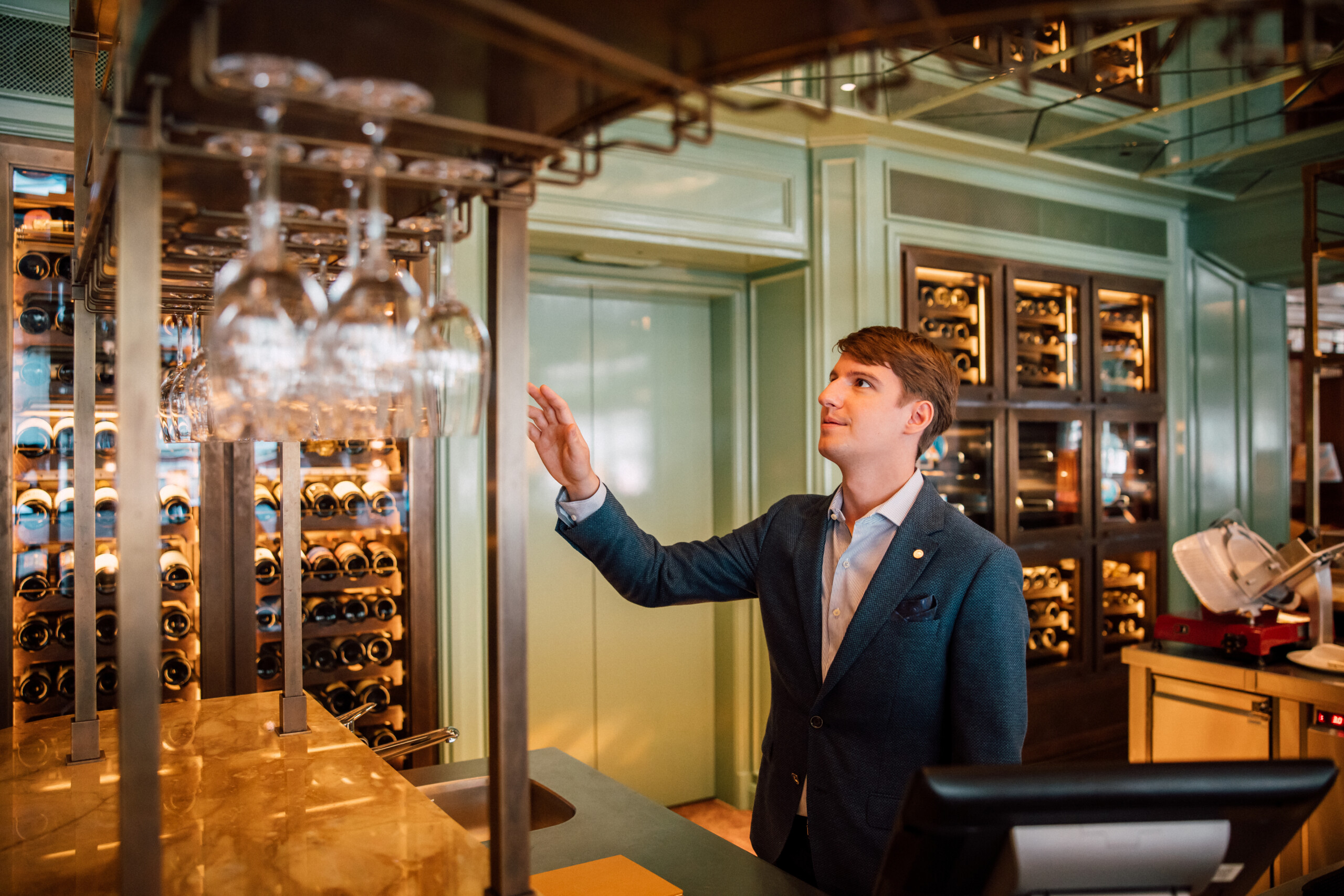
G: How do you choose the Bordeaux wines for your list, and how do you present them to your customers?
Marc Almert: We are extremely fortunate that our purchasing director, Mr. Aschwanden, has attended the Primeur tastings for 23 or 24 years.
With this experience, he is able to discern whether a wine is ready to be tasted immediately or if it requires aging. Our hotel benefits from an impressive cellar, both on-site and in our wine shop in Regensdorf.
This situation allows us to order wines en Primeur, as we have the ability to age them ourselves and add them to the Baur au Lac list at the optimal time to appreciate their full flavor.
Some wines remain in our cellar for more than 10 years, waiting to reach their peak. Others, younger, can be selected to appear on the list, thus giving us the chance to build a varied collection of vintages for many Châteaux.
We always have one or two red Bordeaux available by the glass. We systematically offer a Bordeaux wine between 7 and 15 years old, to illustrate to our customers how a Bordeaux that has reached a certain maturity can age remarkably well, perfectly complementing the gastronomy we offer.
G: What strategies do you use to highlight lesser-known or underrated wines?
Marc Almert: We offer a Fronsac wine by the glass in our chalet, a restaurant where you can enjoy fondue or raclette during December.
The fact that we have different restaurants also makes it easier to highlight lesser-known wines.
For example, in our brasserie, customers are looking more for good value for money. Therefore, we offer many wines from Côtes de Cadillac, Fronsac, and other similar appellations. On the other hand, in our gourmet restaurant and our brasserie, we prefer to highlight Grand Cru Classés and other high-end Châteaux.
Our wine list truly reflects this difference by offering both more affordably priced wines and wines from more renowned Châteaux.
G: What should we do in Bordeaux to have a better representation on your wine list?
Marc Almert: As a German consumer, Bordeaux has the image of being a region of red wines. I find this regrettable. There are indeed white wines in the Entre Deux Mers that have a lighter and more fruity style, the great white wines of Graves and Pessac Léognan offer more gastronomic and dynamic wines. For example, this weekend I drank a Smith Haut Lafitte Blanc 1997, it was magnificent. Unfortunately, few customers think of Bordeaux Blancs. This is something that merchants, Châteaux, the region, and even ourselves should emphasize: “Bordeaux also offers fantastic white wines.”
Admittedly, there was a period during which Bordeaux had a traditional image. However, this perception is changing thanks to dynamism. Many châteaux are doing an excellent job promoting wine tourism. This greatly contributes to changing this image. When visitors have a superb time, they keep a memorable souvenir of Bordeaux. It’s very likely that once back home or when they go to a restaurant, they’ll want to relive a Bordeaux experience by ordering a Bordeaux wine.
It’s essential to work together and strengthen the ties between merchants, châteaux, importers, distributors, and sommeliers. This collaboration can greatly contribute to promoting Bordeaux. There was a time when, due to the unique system of the Place de Bordeaux, the connections between the estates, consumers, and sommeliers were not as close as they are today.
Tendancies
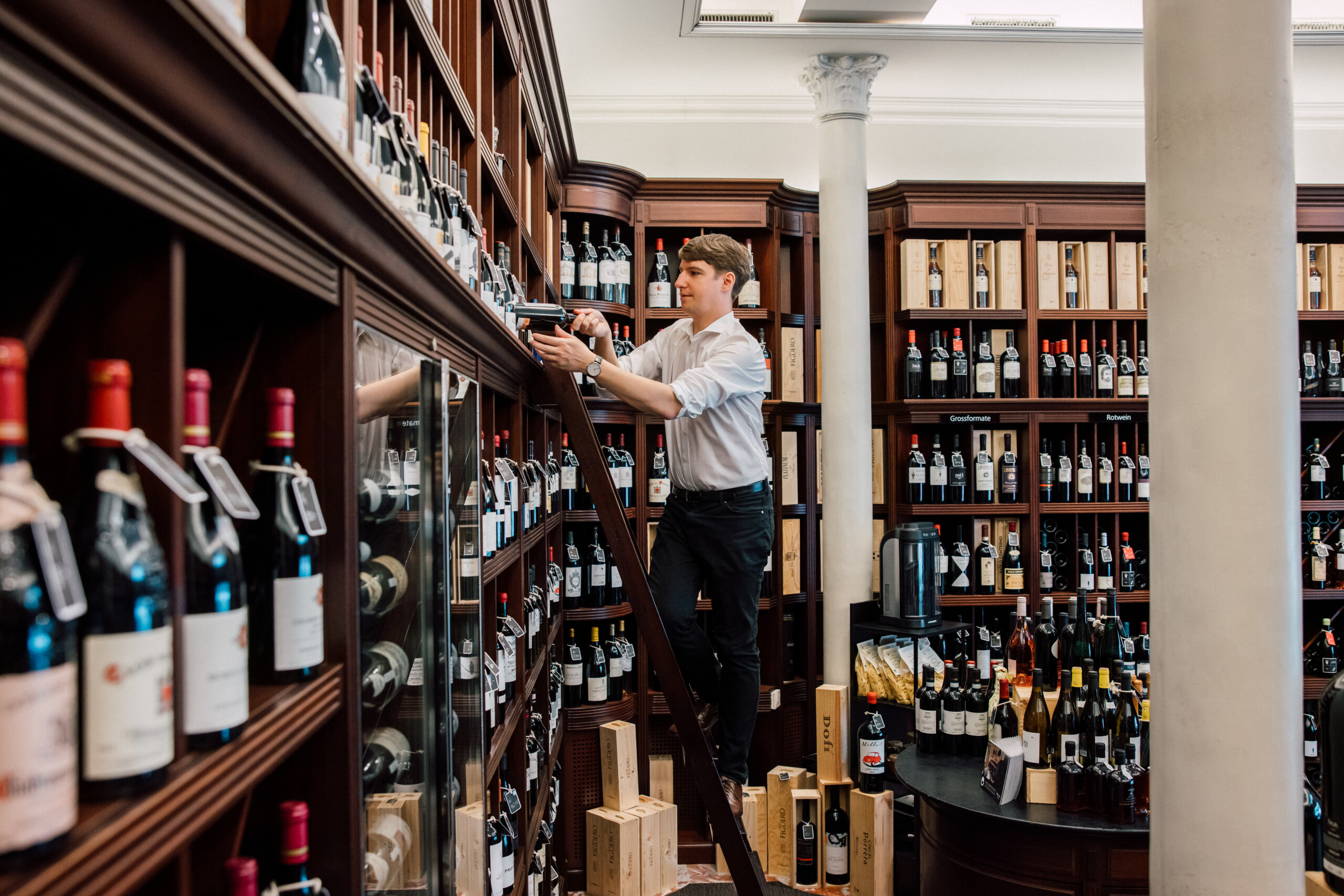
G: Do you notice any current trends in the world of wine? If so, what are the most fashionable trends right now?
Marc Almert: In general, I observe a strong demand for organic and biodynamic wines. I am convinced that this trend will continue in the future.
I also believe that consumers are becoming increasingly sensitive to organic practices in vineyard management as well as to sustainability, in a broader sense. For example, Sweden has decided to ban the use of excessively heavy bottles starting next year.
Many wine regions are going through crises and having difficulty selling their wines. It’s crucial to remind winemakers of the essence of quality wine and the true value inherent in a well-crafted vintage. Bordeaux can offer good value for money, but it needs to be communicated.
I also believe in the potential of rosé wines. We have observed the success of Sacha Lichine with his rosé from Château d’Esclans. I think that the demand for rosé wines will not be limited to Provence but will extend to Bordeaux as well. Perhaps this could become an entry-level option for some estates and boost demand.
G: Many owners are talking about drinkability today. Do you also notice from your customers this search for more freshness and more tension in the wines?
Marc Almert: Yes and no. I think it’s a theme that’s very present in the media, but when I observe the regions or grape varieties that customers are most looking for, whether at the hotel or in the shop, it’s always wines from Bordeaux, Tuscany, Ribera del Duero, so red wines of a more pronounced style, with a relatively high alcohol content and a marked fruity character.
Thus, this subject is addressed by the media, but in Switzerland, we are still open to somewhat stronger styles.
However, it is necessary to adapt to climate changes, as Bordeaux has already done with the introduction of new grape varieties.
So, it might be time to explore new paths, as I believe no one is looking for a wine with 16 degrees of alcohol or a Pomerol with a high alcohol content.
It might be wise to shift focus towards other grape varieties, give greater preference to Cabernet Franc, and decrease the prominence of Merlot. This type of decision is already being made in many châteaux, and we will see it more and more in the future.
G: How do you stay up to date with the changing trends in the wine industry, and how does this influence your wine choices?
Marc Almert: I don’t just travel to discover new places, but most importantly to meet people, exchange, and taste together. I come to Bordeaux at least once or twice a year. During my trips, I meet not only producers but also my sommelier friends from around the world. For example, in Denmark, where taste preferences are more modern compared to Switzerland where we have more classic tastes, I have in-depth discussions with my Danish colleague about natural wines. These exchanges are extremely enriching. Of course, I also read a lot of specialized press.
G: What advice would you give to young professionals aspiring to become top-level sommeliers like you?
Marc Almert: I believe that 2 or 3 pieces of advice are extremely important. First of all, it’s always crucial to be curious. I often hear, no, I don’t like this grape variety, or I don’t like Bordeaux. I believe that Bordeaux offers a very wide diversity, so it’s difficult to say, I don’t like Bordeaux. One should not close off to something or have too fixed an idea. It’s necessary to remain open because the world of wine changes all the time. If possible, one should travel a lot to feed this curiosity. Exchanging with wine estates and tasting extensively is essential.
Maintaining a certain discipline is also important, even if it’s not the most attractive aspect of our profession. We work a lot, but it’s necessary to stay active, watch online videos, and be willing to learn every day. As a sommelier, you can’t claim to know everything. There are so many things to discover, as the world of wine is very vast.
G: What is the best way to taste?
Marc Almert: It’s important to start by using a good glass and a good time. I have a preference for tasting before noon because you are fresher in the mind. It’s also essential not to taste too much. Visiting a wine fair is an excellent opportunity to meet and talk with people, and of course, a way to taste wines. However, one should not overdo it.
Even when spitting, it’s hard to remember all the wines and to have precise taste memories. It all depends on the style of wines, but personally, I think that between 40 and 60 tastings at most is a good amount to remember the wines.
G: What is your favorite grape variety?
Marc Almert : As a sommelier, we are lucky to taste so many good things. I don’t really have a specific grape variety that stands out, because it all depends on its origin and the estate that highlights it. The same grape variety can be magnificent in one case and much less impressive in another. Thus, in my cellar, you can find a wide variety of different grape varieties.
G: What is your favorite wine?
Marc Almert: I have to give you the same answer. At Baur au Lac Vins, we have more than 3000 references, so we have a considerable choice. This is the whole beauty of wine; there is such a diversity of offerings.
G: What, in your opinion, is the best food and wine pairing from Bordeaux?
Marc Almert: Another question that is not easy to answer… but I think of a Graves Blanc with a certain maturity paired with a lobster Thermidor. It’s a classic but magnificent food and wine pairing. Personally, I am also a big fan of Sauternes. It’s a pity that sweet wines are generally forgotten. I find that they pair perfectly with foie gras, even if it’s also a classic food and wine pairing, I stand by it because it makes sense. For a red Bordeaux, and this also depends on the style, but lamb is a big favorite. When I’m in Bordeaux, I eat lamb at least 3 times a week. Let’s not forget also rib of veal or rib of beef, which also pair so well with a Bordeaux red wine.
G: You mention a classic pairing: foie gras and Sauternes, but do you dare to pair Sauternes with meat?
Marc Almert: Yes, it can be very interesting, for example, with duck à l’orange. And even Sauternes with seafood, it can work very well. For instance, roasted prawns with a lightly spicy sauce. Bordeaux is a fascinating wine region with a very wide range of options.
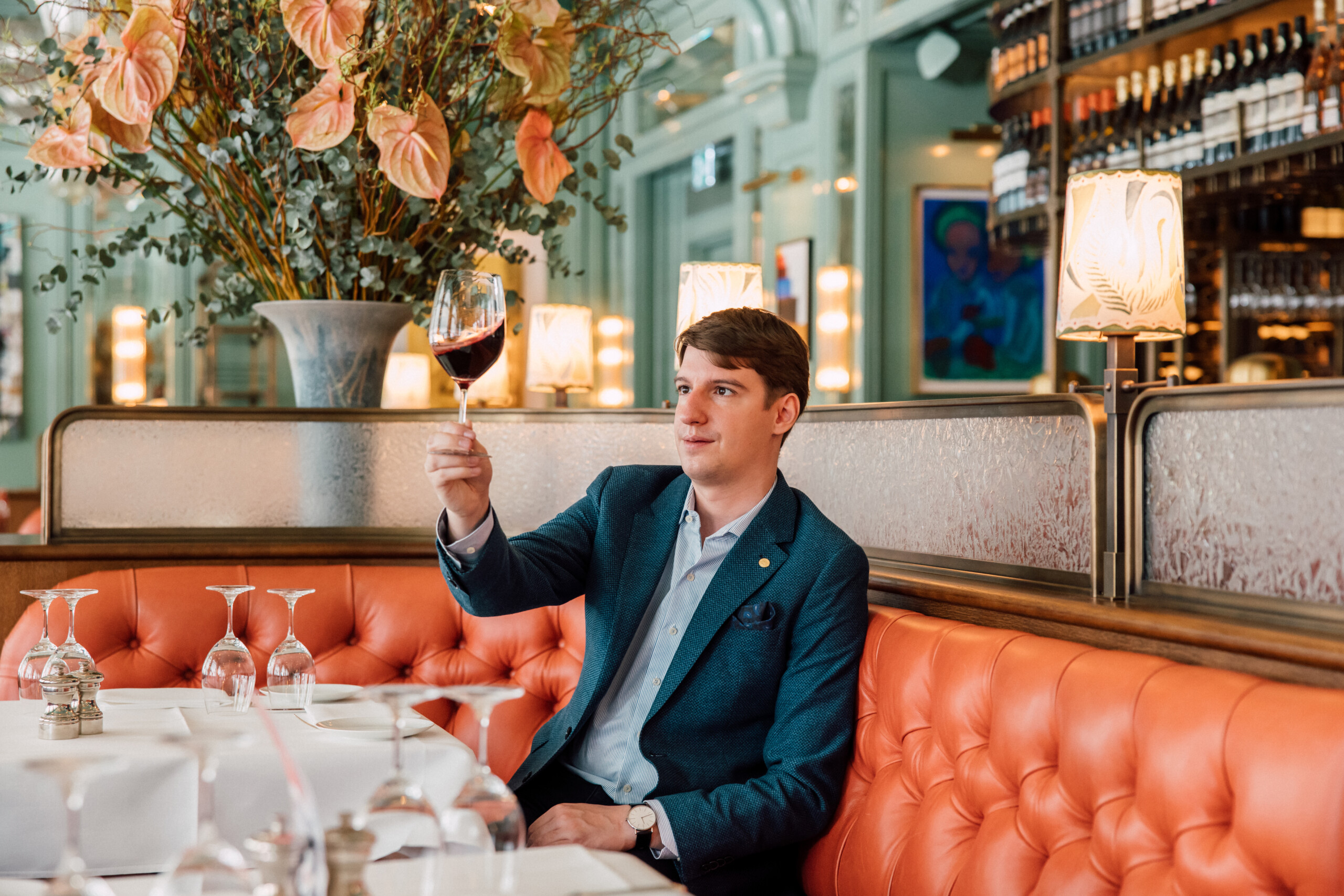
Gerda BEZIADE has an incredible passion for wine, and possesses a perfect knowledge of Bordeaux acquired within prestigious wine merchants for 25 years. Gerda joins Roland Coiffe & Associés in order to bring you, through “Inside La PLACE” more information about the estate we sell.

